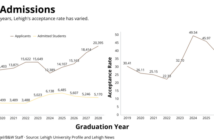Oh unwavering bubble, how you encapsulate our great campus. Won’t you pop already?

Elliott Nasby
The Lehigh bubble is infamous among students, faculty and Bethlehem residents alike as an invisible divide between the university and the town of Bethlehem. But why has it been allowed to persist?
South Bethlehem blames Lehigh students for their carelessness and private-school arrogance. We criticize the town for lacking things to do and being unsafe. Both sides have their arguments, I mean seriously where is our Chipotle already?
Lehigh has been fairly proactive in recent years with its efforts to meld the divide at our campus’ fringes. Small businesses and restaurants on the South Side have done their best to become an inviting and lively place for both students and residents, but despite such efforts the Lehigh bubble lives on.
Are we missing something?
Aside from the many behavioral and social reasons for the bubble, might it have other motives concealed in plain sight? Something out of our immediate control, like a subliminal force field that makes the divide a tangible thing.
A likely culprit: the architectural design of campus. The face of campus could be inadvertently perpetuating the bubble.
What greets the South Side community is not an open gate nor an open space, but a crimson barrier, stretching the length of Morton Street and towering over its short retail buildings. Its uniformity of red brick and apartment windows draws a conspicuous line at the edge of campus that is more of a clenched fist than a beckoning hand.
Whether or not residents of the South Side can pinpoint exactly why, they are subconsciously subject to the forces of the face of our uninviting campus. The idyllic heart of Lehigh’s campus is locked and distant to outsiders. But it wasn’t always this way.
I’ve spent just over one semester living within this bubble, but it didn’t take long to send me looking for answers.
Campus Square — which has since been renamed Farrington Square — constructed in 2002, turns out to be the cherry on top of an improvident cake culminated in years of development and university expansion dating back to the 1950s. After World War II, the U.S. government began incentivizing colleges and universities to expand, unsurprisingly focusing much of its energy on schools with a promising yield of scientists and engineers.
So, Lehigh was put under enormous pressure to add students and property. However, adding more buildings meant uprooting dozens of families and entire blocks on the South Side. Communities were reduced to rubble within months, landing this side of town the fitting name of “The Lost Neighborhood.”
Often times, homes were purchased for reasonable – even generous – prices by the university, but another tactic was getting the city to deem houses blighted, authorizing them to be demolished. And in many cases, a single dilapidated home could warrant the entire block fit for demolition. Among the many repercussions of this project was a severed relationship between Lehigh and South Bethlehem but colloquially, the birth of a bubble.
Decades later, after the construction of Maginnes Hall and Fairchild-Martindale Library, the community was still in need of mending, so Lehigh devised an ingenious scheme to blend together town and university to finally achieve a harmonious relationship with the South Side: a vibrant village center with shops, apartments, and green space.
None other than Campus Square.
Lehigh began construction confident in the new design’s promise, however, the quixotic vision soon faded as funding was cut to make the project less costly and more timely. It was in this way subtle details may have dampened the grand vision. As was the case when the new plan forfeited apartment window balconies for plain red brick to maximize living and parking space.
Fast forward to present day, and Lehigh is again looking to expand with a 400-student dormitory in the works for 2019. The challenge remains of engendering a more mutually beneficial relationship with the Bethlehem community. In the past the seams weren’t cut so evenly, leaving jagged edges where the university grew at the expense of the community.
Perhaps a university is entitled to such presumptuousness. How could we not expect to grow and adapt with time? For a greater good many would argue, cultivation of young minds and leaders, innovation, research and servitude. Lehigh is doing incredible things, and there is no perfect plan.
But it’s still a delicate balance we must strive for, an ongoing process we can continue to learn from. For now, the Lehigh bubble remains but the pin to its popping, I sense, is not far off. In the many tiny details, we might soon find the answer hidden in plain sight.
—
Elliot Nasby, ’20, is an assistant sports editor for The Brown and White. He can be reached at [email protected].





Comment policy
Comments posted to The Brown and White website are reviewed by a moderator before being approved. Incendiary speech or harassing language, including comments targeted at individuals, may be deemed unacceptable and not published. Spam and other soliciting will also be declined.
The Brown and White also reserves the right to not publish entirely anonymous comments.